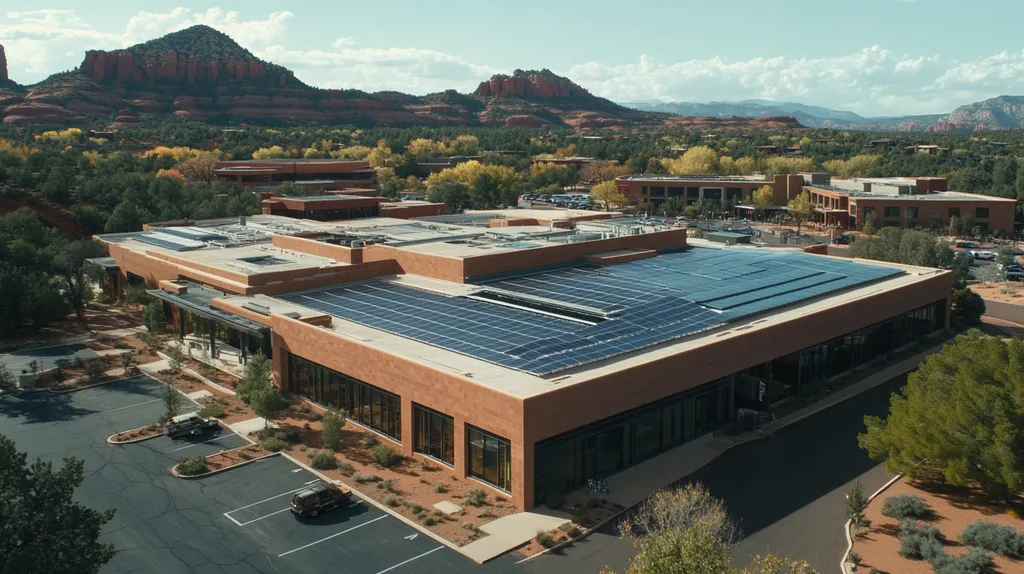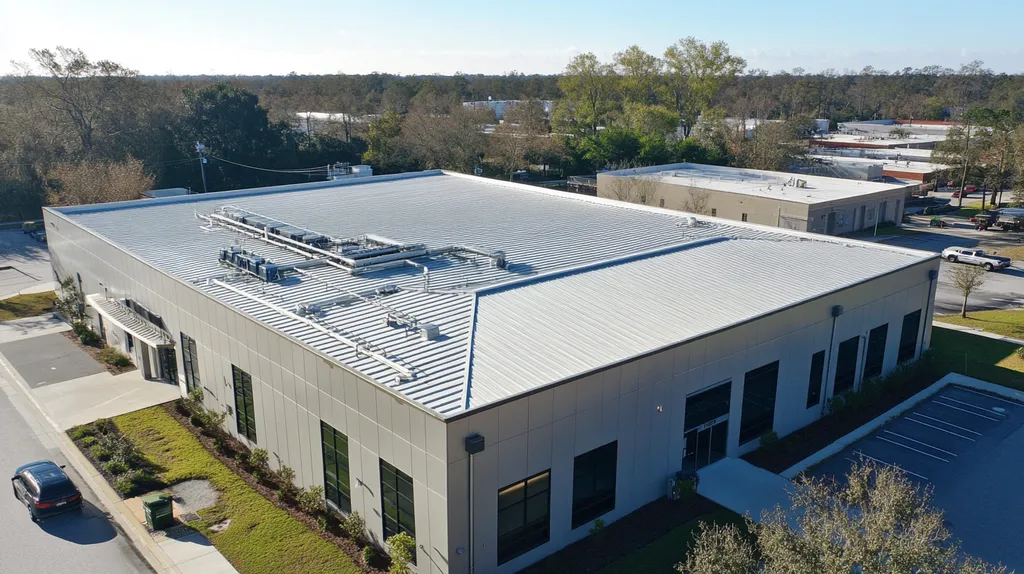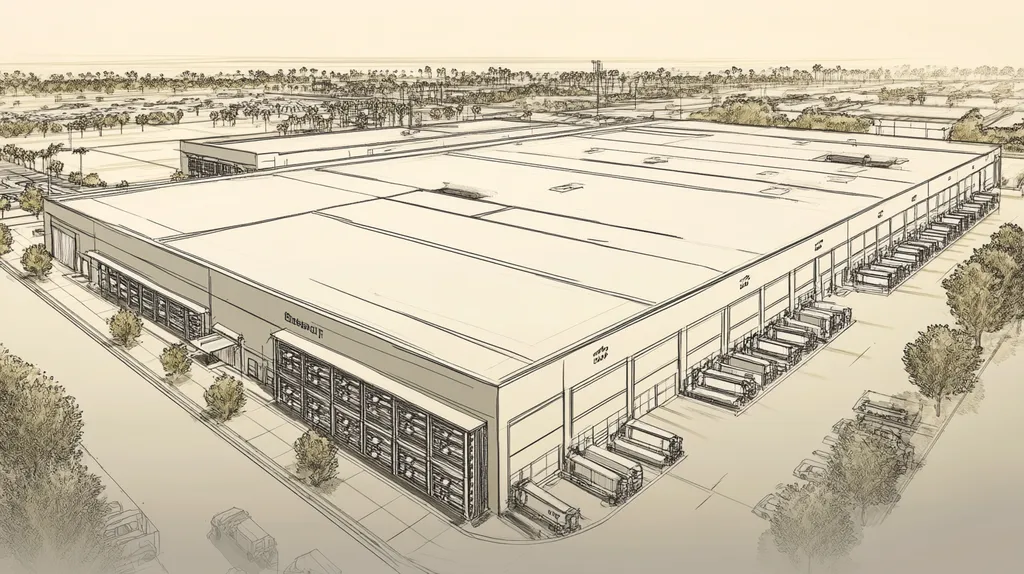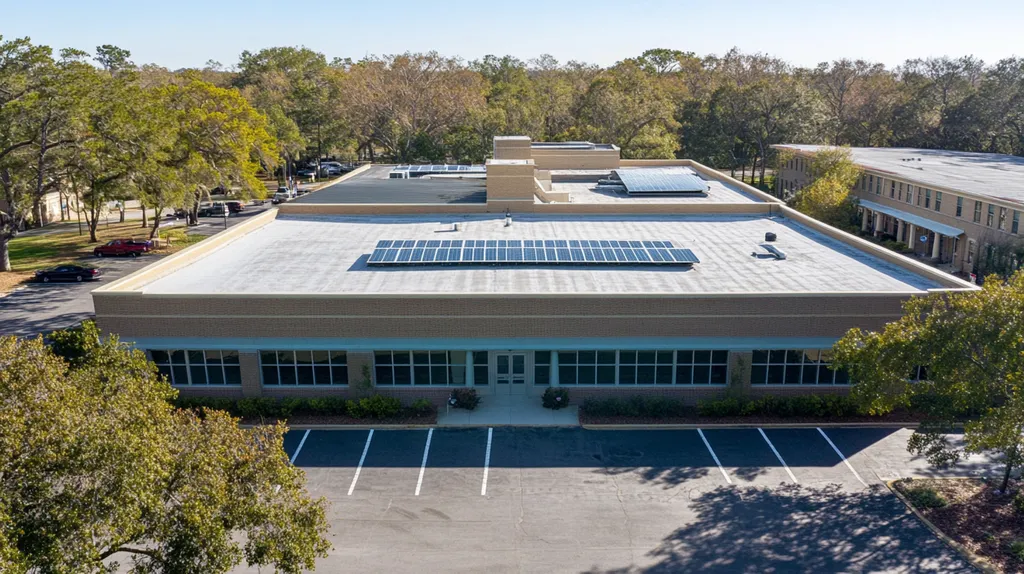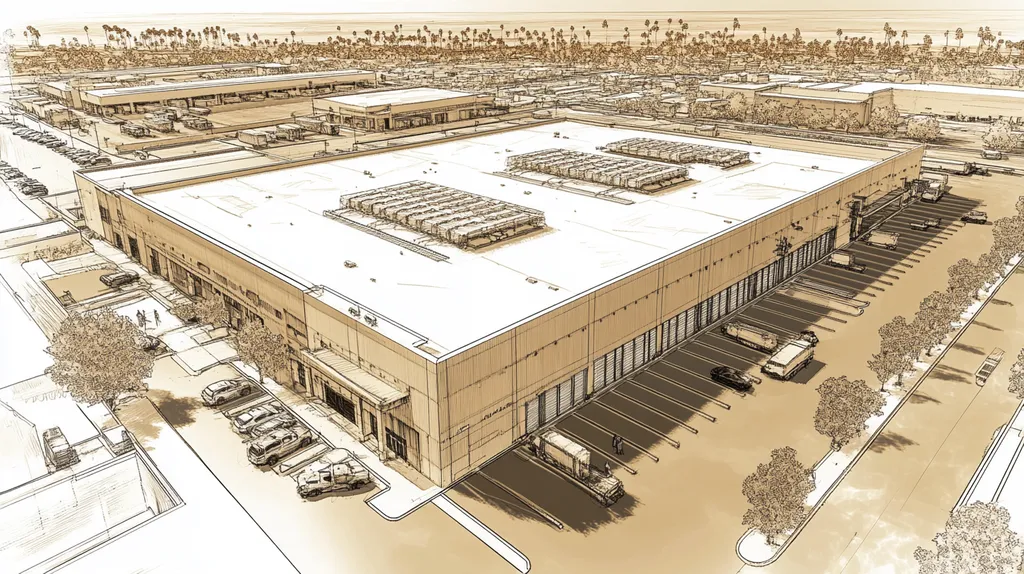When it comes to commercial roof drainage, the writing isn’t just on the wall—it’s dripping down it. Industry data shows that over 40% of all commercial roof failures stem from inadequate drainage systems, yet property owners continue relying on outdated indicators to assess their needs.
From aging infrastructure struggling with increasingly severe weather patterns to compliance gaps in local building codes, the traditional signs for drainage upgrades are proving dangerously insufficient.
This analysis challenges conventional wisdom about drainage system assessment, examining why established indicators fall short and exploring data-driven alternatives that better protect commercial properties.
SECTION 1: CURRENT PRACTICES
Effective drainage isn’t just a nice-to-have for commercial roofs—it’s a must. It directly impacts longevity, safety, and your wallet. In fact, the National Roofing Contractors Association reports that over 50% of roof failures are linked to drainage problems. For property owners and facility managers, getting a grip on existing drainage practices can mean the difference between a thriving roof and a liability waiting to happen.
Standard Drainage System Designs
Most commercial roofs are equipped with either internal or external drainage systems. Internal systems, like roof drains or scuppers, are staples on flat roofs, but they’re notorious for clogging which can create pools of water. On the other hand, external options such as gutters and downspouts can’t handle the deluge when the storm gods unleash fury.
Architects often follow a one-size-fits-all guideline for slope and drainage capacity that pays no heed to the unique quirks of a building or its local climate. This cookie-cutter approach can leave vulnerabilities in areas that are prone to heavy rainfall.
Moreover, many properties overlook the significance of roof topology. A flat roof can look perfectly horizontal but may hide depressions that act as water traps. This makes a solid case for custom drainage designs tailored to each structure’s unique needs.
As weather patterns shift, clinging to standard designs just won’t cut it anymore. Modern property owners must adapt and consider upgraded strategies that reflect changing environmental challenges.
Common Maintenance Schedules
Regular maintenance is crucial for keeping drainage systems in top shape and preventing water-wreaked chaos. Too often, commercial facilities adopt a reactive maintenance approach, fixing issues only when they’re glaringly evident.
Best practices call for more proactive inspections, ideally in the spring and fall. Sadly, many facilities wait until major storms hit to check their drainage systems. This gamble can lead to disastrous outcomes like leaks and structural damage that could have been easily avoided.
Add to that the fact that maintenance teams may lack proper training to spot drainage problems. Without the right knowledge, subtle indicators of a failing system can go unnoticed, paving the way for larger issues to emerge.
Every maintenance strategy should incorporate comprehensive drainage audits. These audits evaluate the existing systems rigorously, comparing performance with modern industry standards to ensure nothing falls through the cracks.
Typical Material Selections
The selection of materials for drainage systems is pivotal to their overall effectiveness. While common materials like PVC and cast iron tend to reign supreme, they may not be suited for every situation. For example, PVC is lightweight but lacks durability and can be an easy target for impact damage.
Property owners frequently choose materials based on upfront costs rather than long-term performance. This shortsighted approach can impact water flow and lead to premature system failures. Investing in higher-quality materials can save a fortune in maintenance woes down the line.
Furthermore, innovative materials like composite systems are quickly emerging, threatening to render traditional choices obsolete. Staying informed about advancements in drainage technologies is key to making smart, future-proof investments.
Lastly, eco-friendly concerns are increasingly shaping material decisions. Green technologies offer practical and sustainable options that not only perform well but also help meet the growing demand for environmentally responsible building practices.
SECTION 2: SYSTEMIC ISSUES
Ignoring drainage issues on commercial roofs isn’t just neglect—it’s an invitation to disaster. Recent industry reports show that poor drainage can culminate in water accumulation, resulting in tens of thousands of dollars in damage. When systemic problems go unrecognized, buildings can deteriorate rapidly, driving up repair costs and putting tenant safety on the line. This isn’t merely a maintenance headache; it’s a looming crisis.
Inadequate Water Drainage Mechanisms
Many commercial roofs are plagued by outdated drainage systems unfit for today’s severe weather. When these systems are poorly designed, they create unwanted water pools instead of channeling water to safe outlets. Property owners often brush this under the rug until the damage story reaches catastrophic levels.
A drainage system’s design should cater specifically to the roof’s configuration and local climate patterns. Aging systems that get clogged with debris amplify water retention, setting the stage for significant property damage. Add to that complexity the fact that ownership shifts often leave maintenance histories murky.
It’s time for property owners to upgrade their drainage mechanisms for improved efficiency, especially during heavy rainfall events. Innovative designs like tapered insulation roofs can redirect water flow much more effectively. Embracing modernized drainage systems allows property owners to proactively mitigate risks before they spiral out of control.
Investing in engineered drainage solutions is not just smart; it’s essential for long-term building protection. A commitment to continuous improvements in drainage systems can significantly lower potential legal liabilities arising from negligence in water management.
Insufficient Regular Inspections
Regular inspections are the backbone of effective drainage management, catching potential pitfalls before they snowball into major crises. Unfortunately, many property owners skip out on scheduling necessary inspections, leading to lapses in critical maintenance. When focused inspections are absent, minor leaks or blockages can fester unnoticed, creating compounded problems over time.
The average lifespan of roofing materials can plummet when drainage systems dodge the regular monitoring they so desperately need. Experts recommend semi-annual inspections, particularly after heavy storms, to identify any abnormalities. A haphazard approach inevitably increases vulnerability to environmental threats.
Implementing a consistent inspection timetable allows property managers to catch potential drainage failures early. These proactive measures not only prolong roofing systems’ lifespan but also ensure compliance with industry standards. A checklist-based inspection process can further streamline evaluating and documenting drainage performance.
Moreover, regular inspections provide valuable insights for property managers, enabling informed decisions regarding necessary upgrades or repairs. By dedicating resources to thorough inspections, companies can effectively trim repair costs while bolstering overall building safety.
Compliance Gaps in Local Codes
Local building codes define the baseline standards for roof drainage, but compliance is often an afterthought for many property owners. In numerous areas, these codes lag behind technological advancements and shifting weather patterns, leading to inadequacies in drainage systems. This oversight not only risks code violations but can also culminate in fines and escalated liability.
Addressing compliance gaps isn’t just an obligation—it’s a strategic move. Staying informed about local regulations and weaving them into maintenance frameworks helps prevent costly penalties. Ignoring this responsibility can compromise a building’s structural integrity and safety.
Staying compliant with local codes also safeguards against complications with insurance claims. A failure to address potential violations could result in denied claims after drainage-related damage strikes. Ensuring compliance is not just about legal checks; it’s a smart business decision.
As climate patterns shift, so too will regulatory standards. Businesses need to remain adaptable, prioritizing code compliance as part of a comprehensive risk management strategy. This dedication ensures robust protection not just for the building, but also for the comfort and safety of tenants and clients.
SECTION 3: MISSED OPPORTUNITIES
In the fast-paced world of commercial roofing, overlooking advanced technologies, skimping on proactive maintenance, and dismissing eco-friendly materials can be serious blunders. These missed opportunities don’t just inflate operational costs; they can skyrocket them by as much as 30%. Upgrading drainage systems isn’t merely about fixing current issues—it’s a golden chance to invest in the future of your roof.
Overlooking Advanced Technologies
The roofing industry is undergoing a technological revolution that can’t be ignored. Smart drainage systems that monitor water levels in real-time are now available, allowing for swift action to prevent water pooling and potential structural damage. Unfortunately, many property owners cling to antiquated systems, blissfully unaware of how modern innovations can drastically improve efficiency.
For instance, cutting-edge sensor technology integrated into drainage systems can provide crucial data about system performance. By leveraging these insights, property owners can make timely upgrades before minor annoyances morph into major headaches. This isn’t just wishful thinking—it’s the future knocking on your roof.
Investing in technology isn’t just a trendy move; it is a practical strategy that pays off. These modern systems often include predictive maintenance alerts, empowering facility managers to act decisively before weather-induced problems escalate. Ignoring these advancements may lead to enormous, unplanned repair bills.
In essence, keeping up with the latest roofing technologies is indispensable for sustaining roof performance. Those who do so find themselves benefitting from enhanced longevity and reliability, while those who don’t risk leaving money on the table.
Neglecting Proactive Maintenance
Proactive maintenance is akin to preventive medicine—it’s essential for keeping drainage systems healthy. Regular inspections catch minor issues before they snowball into major disasters. Failing to embrace this proactive approach not only jacks up repair costs but also increases the risk of liability from water damage.
Implementing a routine maintenance schedule can significantly boost a roof’s drainage effectiveness. Regularly cleaning gutters and downspouts prevents blockages that can lead to water backups and system failures. This simple practice extends both the lifespan of the roofing system and the safety of what lies beneath.
Addressing issues as they are identified can save property owners considerable amounts in emergency repairs. Facilities that foster a proactive maintenance culture are less likely to experience catastrophic failures, resulting in improved safety and operational efficiency.
Ultimately, investing in a detailed maintenance plan cultivates a culture of responsibility that protects property investments. This strategy ensures that both longevity and performance of commercial roofs remain top-notch.
Ignoring Eco-Friendly Materials
As the shift toward sustainability gains traction in the construction world, the choice of materials has never been more significant. Overlooking eco-friendly options not only reduces roof efficiency but also raises its environmental impact. Sustainable materials can enhance drainage effectiveness while promoting responsible property management practices.
Take for example pervious roofing materials; they improve water absorption and reduce runoff, thereby minimizing the risk of drainage blockages. These innovations not only aid in effective site drainage but also align with contemporary environmental standards.
Moreover, opting for eco-friendly materials can yield impressive energy savings over time. Roofs constructed from recyclable components can lower heating and cooling costs, offering both financial and environmental benefits. Ignoring these advancements means missing out on valuable opportunities to boost a facility’s energy performance.
By embracing eco-friendly solutions, property owners improve drainage capabilities while also enhancing their sustainability profile. This growing awareness is critical, as stakeholders increasingly prioritize environmentally responsible practices in property management.
SECTION 4: ROOT CAUSES
Proper roof drainage is critical for the longevity of commercial facilities. Unfortunately, many properties are grappling with severe challenges that threaten this vital system. Aging infrastructure has become all too common, leading to insufficient drainage solutions that simply can’t keep up. Coupled with a skilled labor shortage and ever-rising material costs, property owners find themselves in a tough spot. Identifying these root causes can pave the way for more effective drainage upgrades.
Aging Infrastructure Challenges
Aging roofs often find themselves stuck with outdated drainage systems that can’t cope with today’s demands. Many of these systems were designed under guidelines that no longer reflect the intensity and frequency of current rainfall. Consequently, water can accumulate during heavy storms, creating major headaches for property owners.
Indeed, studies reveal that inadequate drainage is linked to over 50% of commercial roof failures. This staggering statistic highlights the urgent need for timely assessments and upgrades, particularly for older buildings. Implementing modern solutions, like additional drains or improved slopes, could significantly alleviate these issues.
Ignoring aging infrastructure not only results in steep repair bills but also poses potential hazards for tenants and visitors. Commercial property owners must prioritize regular evaluations to ensure their drainage systems remain adequate for ever-changing conditions.
Moreover, integrating innovative technologies into replacement infrastructures can significantly enhance overall drainage efficiency. This proactive approach serves as a shield against catastrophic water damage and structural deterioration.
Lack of Skilled Labor
The construction industry is facing a critical shortage of qualified roofing professionals, which is intensifying the challenges that property owners encounter. With many existing crews lacking the specialized training required for effective drainage upgrades, property managers are often left with subpar installation practices.
This absence of skilled labor can result in miscalculations during drainage installations, leading to pooling water and further compromising the roof’s integrity. Thus, the lack of expertise does more than inflate costs—it can delay urgent upgrades necessary to maintain proper function.
Property managers are encouraged to invest in training for current staff or hire specialized contractors to ensure essential upgrades adhere to industry standards. This approach minimizes future risks and boosts system performance.
Ultimately, embedding a commitment to developing workforce skills within sustainable drainage solutions guarantees the longevity and reliability of roofing systems.
Rising Material Costs
In recent years, the costs of roofing materials have soared, impacting budget considerations for drainage upgrades. This financial pressure often leads property owners to delay or defer necessary maintenance, prioritizing short-term savings over long-term viability.
For example, choosing lower-quality materials may seem like a deal but can trigger early failures, necessitating more frequent replacements. This decision can complicate maintaining drainage efficiency, creating even more strain on the system.
Moreover, inflation in transportation and production costs has severely impacted the roofing industry. As prices rise, property managers are forced to allocate resources in less-than-ideal ways, often placing critical upgrades on the back burner.
To combat these rising expenses, building owners should explore alternative materials or financing options. Investing in high-performance materials may offer a durable, long-lasting solution that helps minimize future costs.
In essence, understanding the factors influencing rising material costs enables property managers to make informed choices—ensuring effective drainage systems while navigating their budgets wisely.
DATA DRIVEN EVIDENCE
The need for effective drainage in commercial roofing is more urgent than ever. The National Weather Service reports that rainfall intensity has surged by 71% in certain areas over the past three decades. Ignoring drainage upgrades doesn’t just invite immediate damage; it sets the stage for potentially catastrophic long-term structural issues. The hard data makes it clear: it’s time to reevaluate existing drainage systems and address those overlooked vulnerabilities with a methodical, evidence-based approach.
Impact of Heavy Rainfall on Roofs
Heavy rainfall can wreak havoc on a commercial roof without the right drainage system in place. While roofs are designed to manage specific water volumes, extreme storms can produce rates that standard systems simply can’t handle. This inadequate drainage leads to ponding water, which accelerates wear and significantly increases the risk of leaks.
The repercussions don’t stop there. Accumulated water can deform roof membranes and reduce insulation effectiveness, compromising energy performance and driving up utility bills. Upgrading drainage systems is vital not only for preserving the roof but also for protecting the entire structure.
Changing weather patterns mean that relying solely on historical data is no longer sufficient. Regular assessments combined with enhanced engineering solutions are crucial for mitigating potential damage from unexpected deluges. Proactive drainage systems preserve roofs and ultimately extend their longevity.
Data suggests that buildings with modernized drainage are substantially less likely to suffer severe damage during intense rain events, making this investment a financially savvy decision in the long run.
Statistics on Drainage System Failures
The statistics surrounding drainage system failures tell a sobering story for property owners. Research from the National Roofing Contractors Association indicates that about 25% of commercial roofs run into issues due to subpar drainage systems. Alarmingly, around 70% of roof leaks can be traced to improperly designed or outdated drainage solutions.
This isn’t just about repair; it also endangers the safety of a building’s occupants. Insufficient drainage can lead to water intrusion, resulting in electrical malfunctions and health hazards due to mold growth. The urgency of upgrading drainage systems has never been clearer.
The cost implications of these failures can be staggering. Property owners might face repair bills ranging from $2,000 to $12,000 for minor leaks, while comprehensive roof replacements due to neglected drainage can soar to over $50,000. These figures reinforce the critical importance of proactive measures.
Thus, property owners must evaluate their existing drainage systems against current statistical data trends. Taking immediate action to enhance drainage capabilities can prevent minor issues from escalating into major financial disasters.
Cost Analysis of Neglected Maintenance
Neglecting regular maintenance and upgrades for drainage systems can lead to exponentially higher costs down the road. Failing to address necessary updates can result in debris blockages, causing flooding and the need for extensive restorations. These major restorations can cost three to five times more than routine maintenance.
Moreover, prolonged exposure to water weakens roofing materials and threatens structural integrity, leading to replacements that hit the wallet hard. Many facility managers overlook these cumulative costs when balancing operational budgets, unaware of the financial pitfalls of inaction.
While investing in modern drainage technology may require an upfront commitment, the long-term savings from avoiding severe damage and repair costs make a compelling case for prioritizing these upgrades.
Continuous analysis of maintenance costs is essential. Combining regular evaluations with data-driven decisions regarding drainage improvements not only safeguards property investments but also ensures their longevity.
SECTION 6: ALTERNATIVE SOLUTIONS
The need for effective drainage solutions in commercial roofing is more pressing than ever. When drainage falls short, the consequences can be severe—think water damage, structural headaches, and unhappy tenants. It’s estimated that around 40% of commercial roof failures stem from drainage issues. To tackle this challenge head-on, property owners and facility managers need to explore alternatives beyond traditional practices. This section delves into enhancing drainage system capacity, implementing regular roof inspections, and adopting innovative roofing materials.
Enhancing Drainage System Capacity
Boosting the capacity of existing drainage systems is essential for mitigating water buildup. Many commercial roofs are designed to handle only average rainfall, leaving them vulnerable during extreme weather events. Upgrading to larger drain outlets or adding extra drains can significantly improve water flow and limit pooling.
Incorporating well-placed channel systems or scuppers can also direct water runoff more efficiently. Properties located in heavy rainfall zones should seriously consider these adjustments. By taking these steps, minor leaks can be prevented from escalating into costly repairs.
Regular assessments of drainage systems can help identify areas requiring increased capacity. Spotting potential bottlenecks enables property owners to address weaknesses proactively, avoiding costly failures before they occur.
Investing in enhanced drainage truly pays off, offering long-term savings and peace of mind. However, a reliable drainage system acts as an essential barrier against severe water damage.
Implementing Regular Roof Inspections
Frequent roof inspections are vital for keeping drainage systems in top shape. Regular assessments allow facility managers to uncover and resolve drainage problems before they snowball into major issues.
Experts recommend at least two inspections a year, or often more in areas prone to heavy rain or snow. During these checks, qualified professionals can identify clogs, assess water flow, and evaluate overall roof health.
Additionally, regular inspections not only boost warranty validity but also ensure compliance with manufacturer maintenance requirements. This added diligence protects investments and keeps roofs functioning at their best.
Establishing a consistent inspection schedule minimizes risks while extending the roof’s lifespan. This proactive approach saves significant costs compared to the expenses of sudden, unexpected repairs.
Adopting Innovative Roofing Materials
Advancements in roofing materials have unveiled several innovative options that bolster drainage effectiveness. Reflective coatings not only enhance energy efficiency but also help prevent water from pooling on the roof surface.
Utilizing permeable membranes can enable quicker water absorption, enhancing overall drainage performance. Materials like thermoplastic polyolefin (TPO) are gaining popularity because of their lightweight design and excellent drainage properties.
Moreover, smart technologies are making their way into roofing solutions. Some modern materials have built-in sensors that monitor drainage conditions in real-time, alerting facility managers to potential issues before they escalate into problems.
By embracing cutting-edge materials, property owners can significantly improve drainage performance. These innovations not only reduce the risk of water damage but also contribute to the sustainability of the entire building.
The Bottom Line
The writing is quite literally on the wall—and the roof—when it comes to commercial drainage upgrades. With 40% of roof failures stemming from drainage issues and repair costs skyrocketing past $50,000, the industry can no longer afford to rely on outdated indicators.
Traditional assessment methods are proving dangerously inadequate against increasingly severe weather patterns and aging infrastructure challenges.
Smart sensors, eco-friendly materials, and proactive maintenance protocols aren’t just buzzwords—they’re essential tools for survival in an era of unprecedented rainfall intensity.
The data is clear: property owners who continue clinging to conventional drainage wisdom aren’t just gambling with their buildings—they’re practically inviting disaster. The time for upgrading commercial roof drainage systems isn’t coming—it’s already here.
FREQUENTLY ASKED QUESTIONS
Q. What are current practices for commercial roof drainage?
A. Effective drainage is essential for longevity and safety in commercial roofing. Poor systems, often outdated, lead to clogs and potential failures, affecting your wallet significantly. Understanding existing practices allows property managers to proactively avoid costly mistakes, securing the roof’s performance while also ensuring tenant safety.
Q. How do systemic issues affect industrial roof drainage?
A. Ignoring drainage systemic issues can be disastrous, leading to substantial damage and liabilities. Outdated and poorly designed systems can cause water pooling, increasing risk for structural integrity. Upgrading drainage mechanisms specifically designed for your roof configuration is vital to prevent these costly disruptions and safeguard tenant safety.
Q. What are the missed opportunities in commercial roof upgrades?
A. Overlooking advanced technologies and proactive maintenance can inflate operational costs by as much as 30%. Ignoring eco-friendly materials also limits drainage efficiency and increases environmental impact. Each upgrade or technology enhancement is an investment into resilient roofing that keeps expenses at bay and enhances safety.
Q. What root causes lead to drainage issues in commercial roofs?
A. Aging infrastructure, skilled labor shortages, and rising material costs are major culprits in drainage problems. Outdated drainage systems struggle to meet modern demands, increasing risks of failure. Identifying these issues allows property owners to strategically invest in valuable upgrades, ensuring reliability over time.
Q. How does data support the need for improved drainage systems?
A. Statistical data show that 25% of commercial roofing issues stem from inadequate drainage systems, with many leaks linked to poor design. Ignoring these statistics can lead to hefty repair bills. Upgrading systems based on solid data allows for proactive measures, preventing minor issues from ballooning into costly disasters.
Q. What alternative solutions exist for industrial roof drainage?
A. Enhancing capacity through larger drains or simple regular inspections can significantly prevent drainage failures. Innovative materials, like permeable membranes, improve performance while reducing costs. By exploring alternatives and updates, property managers can maximize drainage efficiency and effectively combat hefty repair bills.
Q. What unique innovations can improve commercial roof drainage?
A. Innovative technologies like smart sensors that monitor water levels and drainage efficiency are game changers. Additionally, reflective coatings and advanced membrane systems enhance not only drainage but also energy efficiency. Embracing these novel solutions keeps your roof resilient and responsive to modern challenges.


